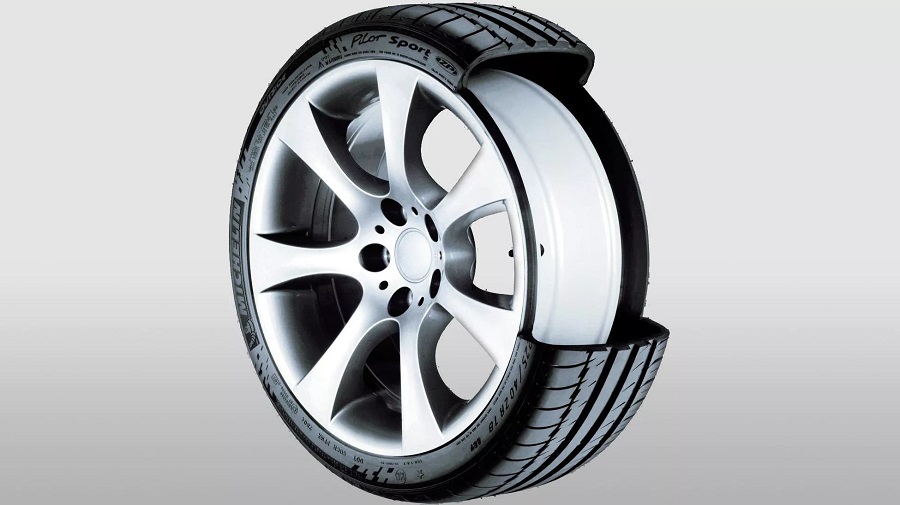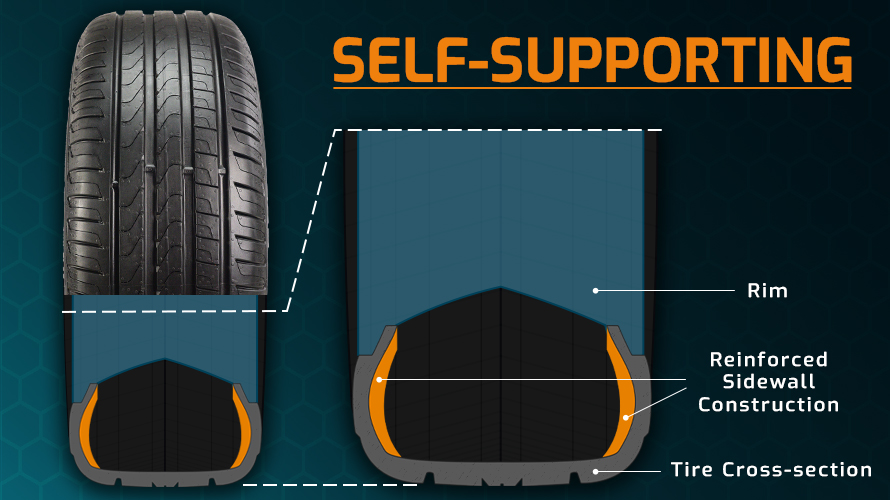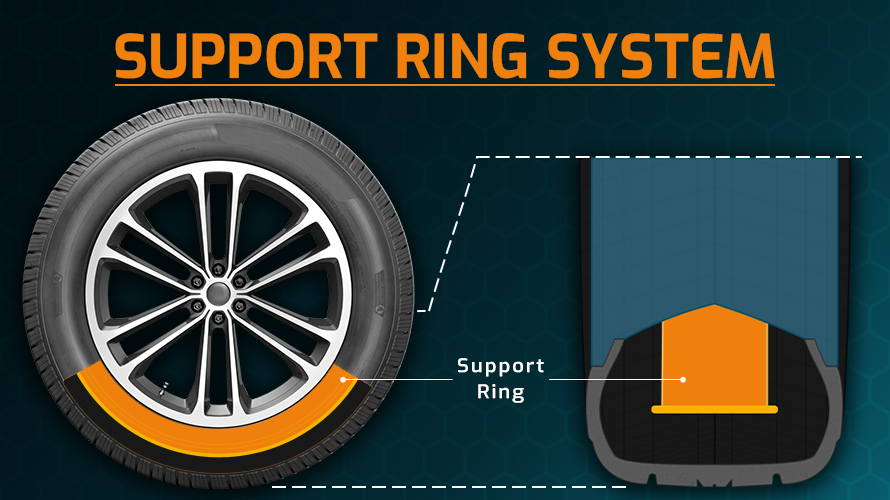Introduction
Run flat tires, also known as RFTs, are a unique kind of tire that is made to continue to provide support and pressure at a specific

level even when fully deflated. This keeps the wheel and tire from getting damaged when the car is driven for a certain distance.
A Brief History of Run Flat Tires
The earliest known use of run flat tires dates back to the early 1900s. But the first run-flat tires to be sold commercially weren’t released until the middle of the 1960s. The ride comfort of these early versions was frequently hampered due to their weight.The technology of run-flat tires has advanced significantly over time. A significant advancement was the development of self-sealing tires, which can autonomously patch minor punctures. In recent times, run-flat tire producers have concentrated on enhancing ride quality and lowering noise levels.
Why Choose Run Flat Tires?
Compared to regular tires, run flat tires provide the following benefits:
- Safety and Convenience: RFTs let you get to a repair shop safely in case of a puncture without affecting the handling or stability of your car. This can be particularly crucial in isolated locations or in times of disaster.
- Decreased Tire Flat Risk: Because of their strengthened sidewalls, RFTs are less prone to flat tires, yet they are still not completely impervious to punctures. Those who travel often and come across road hazards can find comfort in this.
- Enhanced Security: RFTs can prevent robbers from taking your wheels if you have a flat tire. This is due to the fact that replacing a run-flat tire without specific tools is more challenging.
- Increased Fuel Economy: Research indicates that because run-flat tires have less rolling resistance than regular tires, they may provide increased fuel economy.
Run Flat Tires: A Closer Look at Their Types
Run-flat tires are a contemporary invention meant to improve convenience and safety. They avoid a flat tire and the dangers that come with it by enabling a car to drive for a certain amount of distance even after a puncture. Self-supporting run flat tires and support ring run flat tires are the two main varieties of run flat tires.
Self-Supporting Run Flat Tires
Self-supporting run-flat tires, as the name implies, are made to withstand deflation without losing any of their structural integrity. Reinforced sidewalls that offer extra support help achieve this. Steel, Kevlar, or aramid fibers are common materials

used to create these reinforced sidewalls. These strengthened sidewalls keep the tire from collapsing in the case of a puncture, enabling the driver to arrive at a nearby repair facility without risk
Support Ring Run Flat Tires
Conversely, when deflated, support ring run flat tires depend on an extra element to keep their shape. This part is an internal tire support ring that is installed. Usually, the support ring is composed of a stiff substance like plastic or metal. The support ring

keeps the tire from collapsing into the rim in the event of a puncture, enabling the driver to proceed.
Key Differences Between Self-Supporting and Support Ring Run Flat Tires
- Structural Support: Support ring run flat tires need an extra internal component for support, whereas self-supporting run flat tires rely on strengthened sidewalls.
- Weight: Support ring run flat tires may be marginally lighter than self-supporting run flat tires, which are often heavier due to the strengthened sidewalls.
- Cost: Compared to support ring run flat tires, self-supporting run flat tires often have a greater initial cost.
Choosing the Right Run Flat Tire
The decision between self-supporting and support ring run flat tires is influenced by a number of variables, such as driving style, kind of vehicle, and individual preferences. Because they provide more structural support, self-supporting run-flat tires might be a useful choice for people who frequently drive in isolated or uneven terrain. However, people who value weight loss or have a smaller budget could find support ring run flat tires to be a good option.
Benefits of Run Flat Tires
Safety and ease are critical in the fast-paced world of today. Run-flat tires are a relatively new development in vehicle technology, but they’ve already changed the game and greatly benefited drivers.
Increased Safety
The capacity of run flat tires to retain a certain degree of driving capability even after a puncture is one of their most alluring benefits. This is made possible by stronger sidewalls that can sustain the weight of the car and keep the tire from fully collapsing. Because drivers may safely maneuver to a safe area for repairs instead of being stranded on the side of the road, this feature dramatically lowers the danger of accidents.
Enhanced Convenience
The convenience factor is greatly increased with run flat tires. Run-flat tires let vehicles continue their journey, albeit at a slower speed, unlike standard tires, which need to be changed on the spot. This avoids the inconvenience and the risk of changing a tire on a busy road, particularly in bad weather.
Space-Saving
The capacity of run flat tires to free up important trunk space is another useful advantage. Drivers can use the extra space for groceries, luggage, or other possessions because a spare tire and its related equipment are not required. Those who need to transfer stuff in their cars or travel regularly will find this to be especially helpful.
Caution
Although run-flat tires have many benefits, it’s vital to remember that they are not perfect. They are more expensive and have a shorter lifespan than regular tires, among other drawbacks. They could also not be appropriate for all driving situations, especially ones that entail a lot of off-roading or fast driving.
Drawbacks of Run Flat Tires
While run flat tires offer the convenience of driving a flat tire to a safe location, they come with several trade-offs. Here’s a breakdown of some of the key drawbacks:
1. Higher Cost
The fact that run flat tires are more expensive than regular tires is one of its biggest drawbacks. The main cause of this is the specific structure and technology needed to preserve structural integrity even when deflated. The initial outlay could be prohibitive for drivers on a tight budget.
2. Shorter Lifespan and Harsher Ride
In order to offer support when deflated, run flat tires frequently feature stronger sidewalls. This may result in a more difficult ride, particularly on uneven terrain. Furthermore, because it may place greater strain on the tire’s components than traditional tires, the increased rigidity may have a shorter lifespan.
3. Limited Availability and Fewer Repair Options
Run-flat tires might not always be readily available in some places, particularly for certain car models or tire sizes. Drivers who like the convenience of run-flat technology may find this inconvenient and may have to settle for traditional tires. Furthermore, because run flat tires frequently need specific tools and methods to be repaired, doing so might be more difficult and costly than doing it on a regular tire.
Run Flat Tires Maintenance
Run flat tires, designed to maintain a certain level of pressure even after a puncture, offer a unique safety feature. However, they still require proper maintenance to ensure optimal performance and longevity.
The Importance of Regular Tire Checks and Monitoring
- Pressure:Run flat tires maintenance is essential. Reduced fuel efficiency and early wear can result from underinflation. Conversely, overinflation raises the possibility of punctures and degrades riding quality.
- Tread Depth: It’s critical to regularly check the tread depth. Inadequate tread depth on tires can affect grip, particularly in cold or rainy weather.
- Balance and Alignment: Handling is enhanced and uneven tire wear is avoided by maintaining good wheel alignment and balance.
Recommended Best Practices for Maintaining Run Flat Tires
- Follow the Manufacturer’s Recommendations: Follow the tire pressure recommendations found in the owner’s manual for your car at all times.
- Check Tire Pressure Regularly: Check your tires using a trustworthy tire pressure gauge at least once a month, ideally in the winter when the tires are still cold.
- Rotate Tires Periodically: Even wear can be ensured by rotating your tires in accordance with the manufacturer’s recommendations.
- Inspect for Damage: Check your tires frequently for damage indicators including cuts, bulges, and punctures. Make sure an expert inspects it if you find any damage.
- Store Tires Properly: Make sure your tires are correctly inflated and kept in a cool, dry location when storing your car for a long time.
How to Check if Your Vehicle is Equipped with Run Flat Tires
Here are a few methods to determine whether your car has run flat tires:
- Consult the Owner’s Manual: Details on the installed tire type can be found in the owner’s manual for your car.
- Search the Tire Sidewall for a Mark: The sidewall of run-flat tires frequently bears a marking like “RFT” or “RF.”
- Examine the spare tire: Your car probably has run-flat tires if it doesn’t have a spare tire.
Cost Considerations
The ability of run flat tires to support a car even when they are deflated has made them more and more popular in recent years. Before switching, there are a few economic factors to take into account, even though they provide the comfort of being able to drive in the event of a puncture.
Run Flat Tires vs. Traditional Tires
The initial cost of run flat tires is one of the main elements determining the decision to purchase them. Run-flat tires are typically more costly than regular tires. The increased cost is partly attributable to the sophisticated architecture and technology needed to offer this special feature. But it’s important to take into account the overall expenses related to every kind of tire.
Potential Savings: No Spare Tire or Roadside Assistance
By removing the requirement for a spare tire and roadside assistance services, run flat tires may result in financial savings. You don’t have to stop and wait for help to change a tire if you get a puncture and can drive to a local repair shop. Those who frequently drive long distances or reside in places where access to roadside assistance is limited may find this to be especially helpful.
Insurance Considerations
Run flat tires may have an impact on your auto insurance even though they can be convenient and potentially save money. Run-flat tires can lower the risk of accidents and property damage from tire-related breakdowns, hence certain insurance companies may give discounts for such vehicles. To find out if there are any savings or other coverage alternatives available, it’s crucial to contact your insurance company.
Conclusion
Run flat tires offer safety, convenience, and potential fuel efficiency. However, they come with higher costs, reduced comfort, and limitations. Whether they’re worth it depends on your needs and preferences. Consider your driving habits, road conditions, and budget before making a decision.


